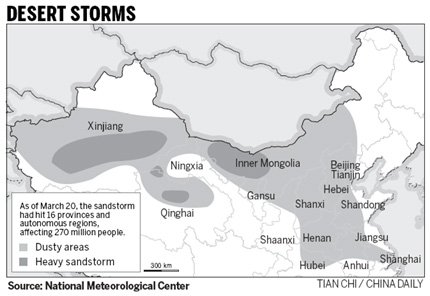Desert storm blankets N. China
The sky across North China turned dark yellow over the weekend as the biggest sandstorm this year offered a grim reminder of the impact of the country's worsening desertification.
![Dust sweeps through Tian'anmen Square in central Beijing on Saturday as North China reeled under a huge sandstorm. [China Daily] Dust sweeps through Tian'anmen Square in central Beijing on Saturday as North China reeled under a huge sandstorm. [China Daily]](http://images.china.cn/attachement/jpg/site1007/20100322/00114320f5750d1107ed03.jpg) |
|
Dust sweeps through Tian'anmen Square in central Beijing on Saturday as North China reeled under a huge sandstorm. [China Daily] |
Thanks to overgrazing, deforestation, urbanization and drought, deserts now make up more than 16 percent of the country, and scientists say the shifting sands are increasing the risk of sandstorms - the grit from which could travel as far as the western United States.
The Chinese Academy of Sciences estimates that the number of sandstorms has jumped six-fold in the past 50 years to two dozen a year.
Around 80 percent of sandstorms occur between March and May, with the country experiencing an average of 5.2 dusty days - often a byproduct of sandstorms - in April, said Lin Jian, chief forecaster with the China Meteorological Administration.
However, as the dusty weather started later than usual this year, it could indicate that the number of sandstorms may be fewer than in recent years, he said.
In Beijing, residents woke on Saturday morning to find the city's streets blanketed by yellow dust. According to the National Meteorological Center, the sand traveled from deserts in the Mongolian People's Republic and the Inner Mongolia autonomous region.
China's national weather bureau gave the air quality a rare 5 rating - "heavily polluted" - and visibility was so bad that several flights had to be delayed at Beijing Capital International Airport, according to staff. The high-speed rail service between Beijing and Shijiazhuang, Hebei province, was also suspended for about two hours.
Residents were advised to keep windows closed, and to use masks and scarves to protect their eyes and mouths while outside.
"Sandstorms can cause serious illnesses, and can affect the eyes and respiratory system," said Chao Enxiang, a doctor with the capital's China-Japan Friendship Hospital. "If this storm continues, hospitals will definitely see the number of patients increase."
The storm also affected power supplies in cities across North China, and even severed Internet links for several hours. Drivers had to turn on their car headlights to see through the midday dust, while some of the passenger ships scheduled to leave ports in Shandong province were delayed.
Wei Shenglou, a farmer in Shaanxi province's Fuping county, said more than 1,000 of his chickens died when strong winds destroyed a coop on his farm on Friday night. "We seldom have such big storms these days. No one was prepared for it," he said. And in nearby Xi'an, the provincial capital, office worker Cao Min said her cell phone was covered with a thick layer of dust in the time it took her to send a short text message.
"It's not the worst," said Wu Bing, a journalist in Lanzhou, capital of Gansu province. "You know, that's what it's like in the west. We've got used to it."
 |
In Hotan prefecture in Xinjiang, visibility dropped to less than 300 meters and at least 14 regional flights linking Urumqi, the regional capital, with Hotan, Aksu, Kashi and Bayingolin prefectures were delayed, said Urumqi airport authorities.
"Visibility was about 10 meters at one point," said Wang Haizhou, 34, a farmer living in the city of Kuerle, northern Xinjiang. "We tried not to go out. If we did, we wore facemasks and glasses. We could see layers of dust at home even when all the windows and doors were closed."
 0
0 







Go to Forum >>0 Comments